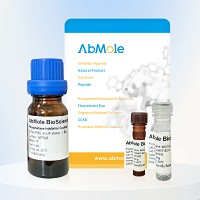All AbMole products are for research use only, cannot be used for human consumption.

ATP (Adenosine 5'-triphosphate) magnesium is a central component of energy storage and metabolism in vivo. ATP dimagnesium provides the metabolic energy to drive metabolic pumps and serves as a coenzyme in cells. Adenosine 5γ-triphosphate (ATP) is a central component of energy storage and metabolism in vivo. ATP is use in many cellular processes, respiration, biosynthetic reactions, motility, and cell division. ATP is a substrate of many kinases involved in cell signaling and of adenylate cyclase(s) that produce the second messenger cAMP. ATP provides the metabolic energy to drive metabolic pumps. ATP serves as a coenzyme in a wide array of enzymatic reactions. ATP magnesium is an important endogenous signaling molecule in immunity and inflammation.
| Formula | C10H16N5O13P3.xMg |
| CAS Number | 74804-12-9 |
| Solubility (25°C) | Water 50 mg/mL |
| Storage | -20°C, dry, sealed |
[1] Qi Xi, et al. Pflugers Arch. Regulation of magnesium reabsorption in DCT
[4] P J Garrahan, et al. J Physiol. The stoicheiometry of the sodium pump
[5] S S Bang, et al. Can J Microbiol. Properties of 1-phosphofructokinase from Pseudomonas putida
| Related Metabolite/Endogenous Metabolite Products |
|---|
| Urolithin M7
Urolithin M7 is a metabolite, which is derived from the transformation of ellagitannins, compounds found predominantly in pomegranates, berries, and nuts. This transformation occurs via intestinal microbiota, which convert ellagitannins into various urolithins, including Urolithin M7. Its mode of action involves influencing cellular processes, potentially modulating mitochondrial function and autophagy pathways. |
| L-Ornithine-15N2 hydrochloride
L-Ornithine-15N2 hydrochloride is the 15N-labeled L-Ornithine hydrochloride. L-Ornithine hydrochloride is a free amino acid that plays a central role in the urea cycle and is also important for the disposal of excess nitrogen. |
| D-Glucose-13C6
D-Glucose-13C6 can be used as a metabolic tracer to trace glucose-related synthetic catabolism or as synthesis ingredient, minimal media reagent, and internal standard. |
| D-Alanine
D-Alanine is a weak GlyR (inhibitory glycine receptor) and PMBA agonist, with an EC50 of 9 mM for GlyR. |
| Quercetin 7-glucuronide
Quercetin 7-glucuronide can inhibit LDL oxidation. Quercetin 7-glucuronide (Quercetin 7-O-β-glucuronide) can be isolated from Madagascarian Uncarina species. |
All AbMole products are for research use only, cannot be used for human consumption or veterinary use. We do not provide products or services to individuals. Please comply with the intended use and do not use AbMole products for any other purpose.


Products are for research use only. Not for human use. We do not sell to patients.
© Copyright 2010-2024 AbMole BioScience. All Rights Reserved.
